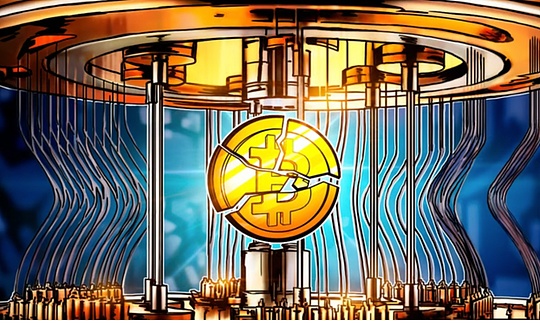

What is the most important thing for Ethereum in the next five years?
Scalability of L1.
Starting this month, Vitalik Buterin and the Ethereum Foundation have made major statements on multiple core issues:From the EIP-7987 proposal (which was originally called EIP-7983 by the community and was officially numbered as EIP-7987) attempting to set an upper limit for a single transaction, to the official entry of L1 zkEVM into the experimental stage, and then to the increase in the block Gas upper limit,All of them indicate that Ethereum L1 expansion accelerates into the fast lane of landing.
It can be said that after the L2 ecosystem achieved phased results, Ethereum has reached the path of refocusing on L1 – Rollup is already fast enough, but L1 can still be lighter, stronger and more unified.
This article will try to sort out the technical context behind this series of updates and briefly talk about how Ethereum L1 plans to achieve the next round of large-scale expansion?
Break and reunite, start from L2 to L1 again
Since Vitalik Buterin published the “Rollup-Centered Roadmap” in 2020, Rollup has become the core strategy for Ethereum’s scalability, giving birth to a series of L2 projects such as Arbitrum and Optimism, and has become the “new continent of Ethereum.”
However, this is the problem with Rollup. There are hundreds of L2 in a broad sense, which not only makes a large number of transactions and value increasingly fragmented on L2, but also L1’s role as data availability and final settlement layer is becoming increasingly heavy.
This inevitably puts L1 under increasingly heavy operating pressure. For example, high Gas transactions (such as blob submissions and zkProof verification) significantly increase the computing and verification burden of L1 nodes. The continuous expansion of state space also affects node synchronization efficiency and on-chain storage costs. At the same time, the fluctuations in Ethereum block packaging time are intensifying, which also poses security and censorship resistance risks.
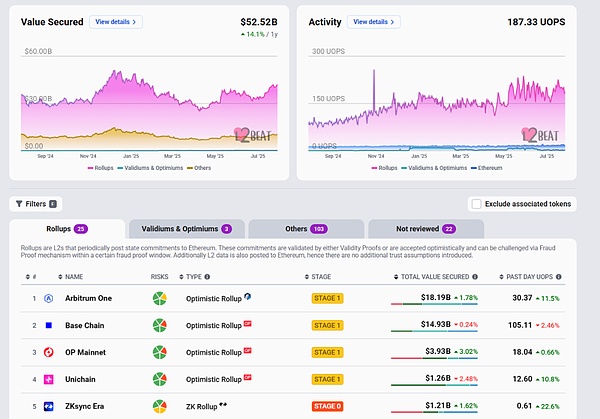
Source: L2Beat
Ultimately, the development trajectory of L2 in the past few years is also a “wall-making history” – various Rollups have built their own liquidity moats, striving to lock users and assets in their own ecology. These high walls have certainly given rise to local efficiency, but they have also weakened the liquidity and unity of Ethereum as an integrated network.
As the saying goes, “If you have a long combination, you will be divided, and if you have a long division, you will be combined.”Ethereum is at a large-cycle turning point from L2 differentiation to L1 reconstruction. To some extent, this is also a phased correction to “L2-centered”:
Make the entire network more like a unified ecosystem, rather than a platter of dozens of split chains, which means that the future asset transfer, state sharing and application switching across L1/L2 should be as smooth and senseless as on a single chain.
For this reason, from Based Rollup to ePBS to L1 zkEVM, the Ethereum Foundation protocol research team and the developer community are systematically promoting a series of L1-level structural optimizations, trying to make the main network stronger execution capabilities, availability and resilience to resist external attacks without sacrificing security and decentralization.
EIP-7987&zkEVM: Injecting the capacity expansion gene into the main network
The two most popular core expansion reform plans in the market are the EIP-7987 proposal and L1 zkEVM, which represent two key dimensions from resource scheduling optimization to execution layer reconstruction.
1. EIP-7987: Limit the Gas limit for a single transaction to alleviate block resource congestion
First, it is recommended to set the EIP-7987 proposal to set the Gas limit for a single transaction of Ethereum to 16.77 million. It was jointly proposed by Vitalik Buterin and Toni Wahrstätter earlier this month. The core idea is to set the maximum Gas limit of 16.77 million for a single transaction (note that this cap is not directly related to the total Gas Limit of each block).
As we all know, in the Ethereum network, each transaction (whether it is a transfer or contract interaction) requires a certain amount of Gas, and the Gas Limit capacity of each Ethereum block is fixed, that is, the pit is limited, which means that if the gas in a single transaction is consumed too much, it is easy to occupy the block transaction resources.
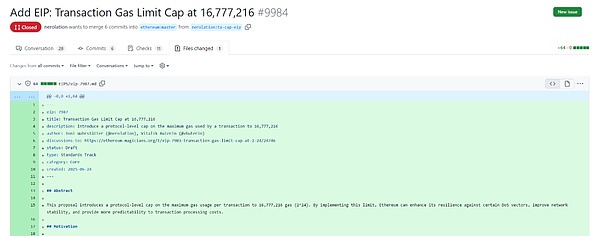
Source: Github
For example, some high-load transactions (such as zkProof verification, large contract deployment, etc.) often consume most of the block space in one transaction, so the original intention of this proposal is to try to avoid a single high-gas operation (such as zkProof verification or large-scale contract deployment) from squeezing the entire block resources, causing congestion in node verification, especially affecting the parallel execution environment and light node synchronization:
By setting an upper limit, some super-large transactions are forced to be split, thereby avoiding the single transaction from occupying too much resources.Only one restriction is introduced during the transaction execution process – if the transaction exceeds this limit before entering the block, it will be rejected during the verification phase.
In addition, not only the Gas cap for a single transaction, but the adjustment to the Ethereum block cap is also underway. On July 21, Vitalik Buterin tweeted, “Almost exactly 50% of stakeholders voted to increase the Gas cap for L1 to 45 million. The Gas cap has begun to increase, now at 37.3 million.”
Theoretically, the expansion of the block Gas upper limit will indeed directly greatly improve the performance of the Ethereum main network. However, in the past, Ethereum has been relatively restrained and cautious in this regard in the context of the great development of L2 and other routes. When looking at the expansion of Ethereum Gas Limit, you will find thatAfter the Ethereum network Gas Limit increased from 8 million to 10 million in September 2019, it has not been this year that Gas Limit has only increased from 8 million to 36 million in six years.
Since the beginning of this year, the Ethereum ecosystem’s publicly discussable attitude towards Gas Limit has become much more “radical”. The EIP-9698 proposal even suggests “to increase ten times every two years” and increase Gas Limit to 3.6 billion by 2029, a hundred times the current one.
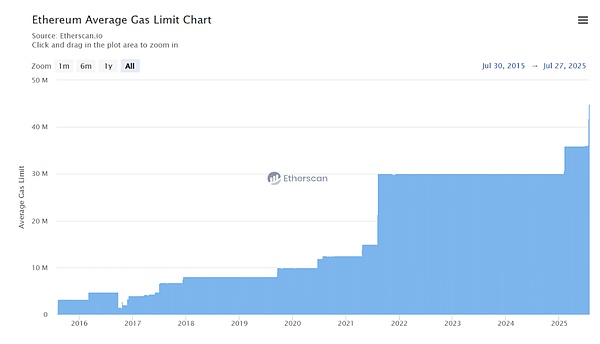
Source: Etherscan
This series of adjustments not only reflects Ethereum’s realistic considerations on the expansion of the main network, but also lays the computing resource foundation for the upcoming zkEVM execution layer upgrade.
2. L1 zkEVM: Zero-knowledge proof for reconstruction execution architecture for main network
zkEVM has always been regarded as one of the “endgame” to expand Ethereum. The core design idea is to enable the Ethereum main network to support ZK circuit verification, so that the execution of each block can generate verifiable zero-knowledge proofs, which can be quickly confirmed by other nodes.
Specific advantages include that nodes do not need to repeat each transaction. Just verify zkProof to confirm the validity of the block, and effectively reduce the burden on the entire node, enhance the friendliness of light nodes and cross-chain validators, and improve security boundaries and tamper resistance.
At present, the concept of L1 zkEVM is also being implemented at a faster pace.On the 10th of this month, the Ethereum Foundation just released the L1 zkEVM real-time proof standard, as the first step in its comprehensive adoption of the zero-knowledge proof technology route.The Ethereum mainnet has gradually transitioned to an execution environment that supports the zkEVM verification mechanism.
According to its publicly disclosed roadmap, Ethereum L1 zkEVM will be launched within one year, using the simplicity of zk-proof to safely expand Ethereum, and gradually integrate the ZK proof mechanism into all levels of the Ethereum protocol. For Ethereum, this is also a concentrated practical test of its related technology reserves and implementation over the years.
This means that the Ethereum main network will no longer be just a settlement layer, but an execution platform with self-verification capabilities – the so-called “verifiable world computer”.
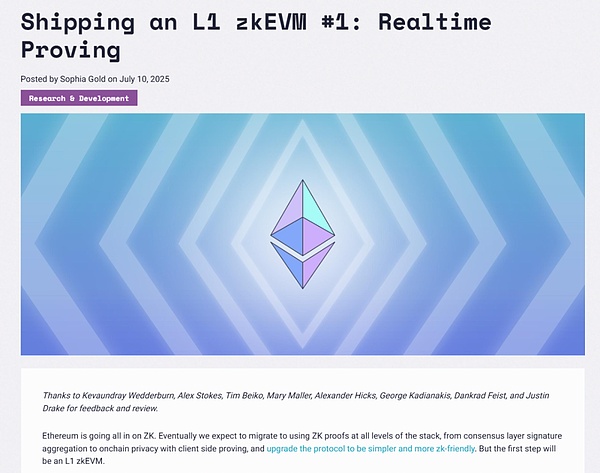
Overall,If EIP-7987 improves execution efficiency in microscopic scheduling, L1 zkEVM realizes qualitative change in the macroscopic architecture, which is expected to bring about 10 to 100 times the execution performance improvement, and at the same time reconstruct the “value capture capability” of the Ethereum main network.
From being a settlement layer only to becoming a verifiable execution engine, L1 itself will assume more connection portals for users, assets and liquidity, and will also be more capable of directly coping with the competition of high-performance new public chains such as Solana and Monad.
Of course, in addition to the transaction processing and execution architecture itself, Ethereum has also made comprehensive innovations in the broader resource management and governance mechanisms.
Other combinations of L1 expansion
Beyond EIP-7987 and zkEVM,Ethereum’s capacity expansion and upgrading at the main network layer is making full efforts from multiple underlying modules to gradually build a high-performance, low-threshold, strong and fair on-chain execution environment.
For example, the Ethereum Foundation is promoting architectural optimization called ePBS, and plans to completely separate the roles of block proposals and block builders, aiming to systematically solve the problems of MEV extraction imbalance and construction rights monopoly, and enhance the fairness, censorship resistance and transparency of block production from a mechanism perspective.
More importantly, ePBS is deeply integrating with another key component, FOCIL. The core goal of FOCIL is to allow light nodes to verify block and transaction execution results without maintaining the complete state online. Combined with ePBS, Ethereum’s proposal, construction and verification process in the future will form a clear “separation of powers” architecture, significantly improving protocol flexibility.
At the same time, this combination also provides more possibilities for scenarios such as privacy transactions, light nodes, mobile wallets, and lowers the threshold for participation. This marks that Ethereum is gradually moving towards a “modular consensus architecture”, bringing stronger composability and institutional flexibility to the decentralized system.
Another underestimated but highly valuable expansion path is the Stateless Ethereum architecture. The core idea is to completely reduce the dependence of nodes on “full-chain state”.By introducing a witness (status proof) mechanism, nodes only need to download data related to verifying the current transaction, greatly reducing the cost of synchronization and verification.
To this end, EF is promoting a visualization tool called bloatnet.info, quantifying the unbalanced burden brought by state inflation to the network, and providing a support basis for future state cleaning, streamlining mechanisms and state leasing models.
In addition, the Ethereum research team previously focused on the Beam proposal, setting independent price curves for resource types such as computing, storage, and calling. The goal is to introduce a more refined resource pricing mechanism for Ethereum, and is committed to transforming Ethereum from a “single-dimensional billing system” to a “multi-dimensional resource market”, similar to the resource scheduling system of traditional cloud computing.
Written at the end
To be honest, with Rollup expansion becoming the mainstream and account abstraction is becoming increasingly popular, many people may place their hopes on the L2 model of “off-chain execution + mainnet settlement”.
But the reality is,The evolution of L1 has never stopped and cannot be replaced.
L2 can carry more users and free up execution space, while L1 provides unified settlement, security anchors and resource governance foundations. Only when the two evolve together can a truly sustainable, high-performance, globally universal Web3 value network be built.
In the future, only by achieving the coordinated evolution of L1 and L2 can we move towards a truly unified world computer.


